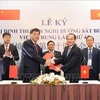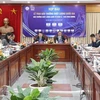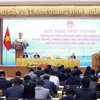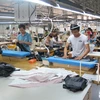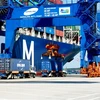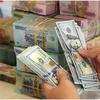In 2014, the Government took the initiative to speed up restructuring of State-owned enterprises, but it also needs to strengthen its focus on another pillar of the economy, the private sector, which is key to the nation's future success, said Wendy Jo Werner, the World Bank Group's Practice Group Manager on Trade and Competitiveness for the East Asia and Pacific region.
Q: What is your assessment of each of Vietnam's three main economic pillars: state-owned enterprises (SOEs), foreign direct investment (FDI) enterprises and the private sector? Of these groups, which is experiencing the most difficulties in accessing credit, support policies and technology?
A: As reported in the World Bank annual series "Taking Stock" published in December 2014, the foreign-invested sector continues to be a significant source of growth for Vietnam, contributing approximately 20 percent of GDP, supplying two-thirds of merchandise exports and providing a quarter of employment in the enterprise sector. This sector's vitality and growth is further illustrated by the Purchasing Managers' Index (PMI), which remains above the critical value of 50.
In contrast, domestic-owned businesses, once the major driver of Vietnam's economic growth, have not overcome the pressing challenges of recent years. This is evidenced by a 9 percent increase in the number of domestic-owned businesses closing or suspending operations during the first 10 months of 2014. The number of newly established businesses has decreased by 6.5 percent over the same period last year. The private sector still features few domestic, private companies. Many are constrained by limited access to finances, subdued domestic consumer demand and an uneven playing field with the SOE sector.
SOEs which are less capital-efficient than companies in the private sector, but still play a considerable part in the Vietnamese economy. SOE reform will be critical for improving economy-wide productivity and growth. Recently, we have seen an increase in the momentum of SOE reform. Since June we have seen further actions on equitisation, but overall its results have not met expectations. There is a need to move more quickly on equitisation implementation and to have a clearer roadmap for private sector participation in SOEs.
Q: What are the issues hindering private sector development in Vietnam?
A: Vietnamese enterprises showed remarkable resilience during the global financial crisis, thanks to strong entrepreneurship, and have made significant contributions to poverty reduction and job creation. However, the domestic private sector remains weak, with low productivity and little spending on research and development. Most Vietnamese firms are still small, and have yet to become competitive enough to export or plug into international production networks, principally as in-country suppliers to foreign-invested enterprises.
Overall, Vietnam's corporate enterprise structure is missing a segment to link the domestic, private sector to global value chains. This would help it overcome fragmentation in supply chains.
The absence of a robust supporting industry has long been recognised as a key hindrance to competitiveness and companies trying to move up the value chain. Logistics and supply chain infrastructure will also improve the overall investment environment.
SOEs still enjoy preferential access to capital, resources and support from local authorities, while smaller private business struggle to raise capital and compete with SOEs.
Q: What is your advice to Vietnamese entrepreneurs?
A: As I said, most of the Vietnamese firms are still tiny, so only a handful of companies are able to compete internationally. At the same time, Vietnam has world-class entrepreneurs, who have built successful businesses that create jobs and open new markets. The private sector should and will continue to be the main engine of Vietnam's economic growth and a leader of innovation.
To move up to another level, entrepreneurs need to have long-term visions and investments. They need to invest in human resources, modern technology and partnerships, especially with international companies.
With free trade agreements, potentially the Trans-Pacific Partnership and the overall trend of increasing economic integration, the local market will open up more and more, bringing excellent opportunities for Vietnamese entrepreneurs to link up with foreign and multinational companies. It will also help them participate more actively in global production networks through closer connections to multinational corporations and direct exports.-VNA
Q: What is your assessment of each of Vietnam's three main economic pillars: state-owned enterprises (SOEs), foreign direct investment (FDI) enterprises and the private sector? Of these groups, which is experiencing the most difficulties in accessing credit, support policies and technology?
A: As reported in the World Bank annual series "Taking Stock" published in December 2014, the foreign-invested sector continues to be a significant source of growth for Vietnam, contributing approximately 20 percent of GDP, supplying two-thirds of merchandise exports and providing a quarter of employment in the enterprise sector. This sector's vitality and growth is further illustrated by the Purchasing Managers' Index (PMI), which remains above the critical value of 50.
In contrast, domestic-owned businesses, once the major driver of Vietnam's economic growth, have not overcome the pressing challenges of recent years. This is evidenced by a 9 percent increase in the number of domestic-owned businesses closing or suspending operations during the first 10 months of 2014. The number of newly established businesses has decreased by 6.5 percent over the same period last year. The private sector still features few domestic, private companies. Many are constrained by limited access to finances, subdued domestic consumer demand and an uneven playing field with the SOE sector.
SOEs which are less capital-efficient than companies in the private sector, but still play a considerable part in the Vietnamese economy. SOE reform will be critical for improving economy-wide productivity and growth. Recently, we have seen an increase in the momentum of SOE reform. Since June we have seen further actions on equitisation, but overall its results have not met expectations. There is a need to move more quickly on equitisation implementation and to have a clearer roadmap for private sector participation in SOEs.
Q: What are the issues hindering private sector development in Vietnam?
A: Vietnamese enterprises showed remarkable resilience during the global financial crisis, thanks to strong entrepreneurship, and have made significant contributions to poverty reduction and job creation. However, the domestic private sector remains weak, with low productivity and little spending on research and development. Most Vietnamese firms are still small, and have yet to become competitive enough to export or plug into international production networks, principally as in-country suppliers to foreign-invested enterprises.
Overall, Vietnam's corporate enterprise structure is missing a segment to link the domestic, private sector to global value chains. This would help it overcome fragmentation in supply chains.
The absence of a robust supporting industry has long been recognised as a key hindrance to competitiveness and companies trying to move up the value chain. Logistics and supply chain infrastructure will also improve the overall investment environment.
SOEs still enjoy preferential access to capital, resources and support from local authorities, while smaller private business struggle to raise capital and compete with SOEs.
Q: What is your advice to Vietnamese entrepreneurs?
A: As I said, most of the Vietnamese firms are still tiny, so only a handful of companies are able to compete internationally. At the same time, Vietnam has world-class entrepreneurs, who have built successful businesses that create jobs and open new markets. The private sector should and will continue to be the main engine of Vietnam's economic growth and a leader of innovation.
To move up to another level, entrepreneurs need to have long-term visions and investments. They need to invest in human resources, modern technology and partnerships, especially with international companies.
With free trade agreements, potentially the Trans-Pacific Partnership and the overall trend of increasing economic integration, the local market will open up more and more, bringing excellent opportunities for Vietnamese entrepreneurs to link up with foreign and multinational companies. It will also help them participate more actively in global production networks through closer connections to multinational corporations and direct exports.-VNA
